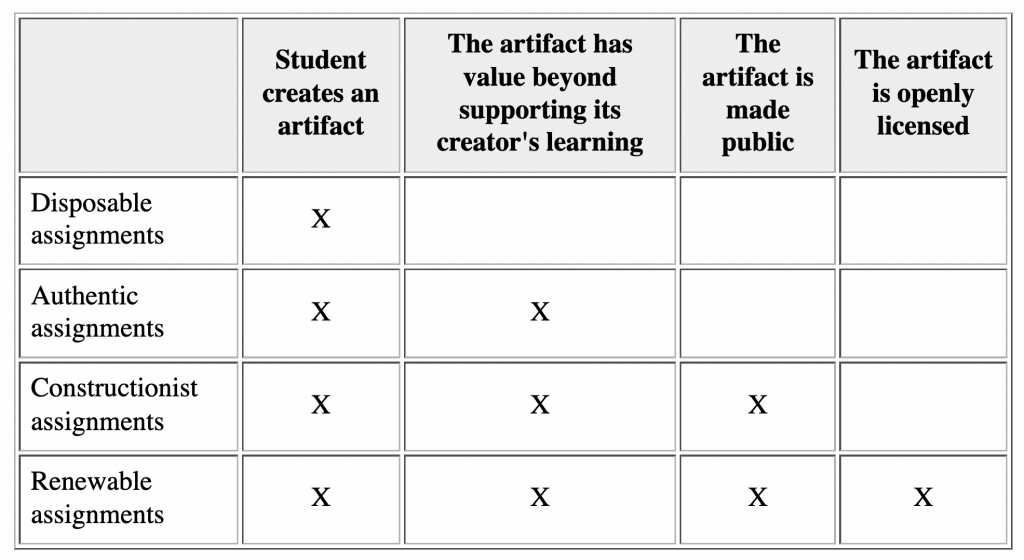In our grant proposal to the Davis Educational Foundation, we explain that we want to design courses more deliberately for—and with—our students. We explain that we will do this by establishing a faculty development initiative centered on open pedagogy. In their oft-cited introduction to open pedagogy, Robin DeRosa and Rajiv Jhangiani clarify that open pedagogy is about more than reducing textbook costs:
Embedded in the social justice commitment to making college affordable for all students is a related belief that knowledge should not be an elite domain. Knowledge consumption and knowledge creation are not separate but parallel processes, as knowledge is co-constructed, contextualized, cumulative, iterative, and recursive. In this way, Open Pedagogy invites us to focus on how we can increase access to higher education and how we can increase access to knowledge–both its reception and its creation. This is, fundamentally, about the dream of a public learning commons, where learners are empowered to shape the world as they encounter it.
DeRosa, Robin, and Rajiv Jhangiani. “Open Pedagogy.” Open Pedagogy Notebook, 16 Mar. 2018.
Our program builds on the work of Jhangiani, DeRosa, and many others by providing a framework through which faculty can engage students as collaborators in their learning.
Open Pedagogy emerged around Open Educational Resources (OER)
To understand open pedagogy, it helps to understand the open education movement. We begin our open pedagogy video series by remixing the excellent OER Starter Kit Workbook created by Stacy Katz and Abby Elder. Their definition of OER is very straightforward:
Open educational resources (OER) are openly-licensed, freely available educational materials that can be modified and redistributed by users. They can include any type of educational resource, from syllabi to full courses.
Katz, Stacy and Abby Elder. “Introduction to Open Educational Resources.” OER Starter Kit Workbook.
We offer more context for this definition in the first video of our series. The link will take you to minute 3:51 in the video, where we get into the details of what OER is and what it is not (resources behind a paywall are not OER, for example, nor are copyrighted works available freely on the Internet). If you’d like to learn more about the creative commons licenses that make it possible for faculty to modify and redistribute educational resources, check out this fantastic introduction by Creative Commons Aotearoa New Zealand:
Not only can faculty adopt OER (saving students money) and adapt or remix OER (making them more relevant and impactful for their students), they can also involve students in the creation of OER. Our disciplines are constantly shifting as new discoveries are made and our students can be involved in communicating what is emerging. This has implications for many aspects of course design, but David Wiley’s concept of “renewable” versus “disposable” assignments illustrates it very well. This chart shows the range of assignments one might use in a course.

One way of engaging with open pedagogy is to try to shift an assignment that might be described as a disposable assignment into an authentic, constructionist, or even renewable assignment. Faculty who have undertaken this shift often report that because the project can or will actually be useful for a real audience their students are more engaged in the work of the course.
Open Pedagogy Examples
Of course, not all assignments can become renewable assignments. It is also very important to respect students’ rights and privacy when designing open assignments (please don’t ever require that their work be made public or openly licensed). We want to emphasize that there are many different ways to engage with open pedagogy in a course (you’ll also see strategies referred to as “open educational practices”). One can get started by collaborating with students on the syllabus or course schedule, which doesn’t require that anything be made public. In what follows, we offer some examples of open pedagogy taking place at our university and beyond.
Co-write Parts of Syllabus/Course with Students
- Students create additional learning objectives
- Students annotate the syllabus and assignments
- Students determine content (one or more weeks)
Create OER with and for Students
- Thinking Historically Site (built with OpenLab)
- Music of Texas Site (built with OpenLab)
- OpenAmLit (built with Pressbooks)
- Transforming Humanities Texts (built with Pressbooks)
- Interdisciplinary Studies (built with Pressbooks)
Collaborate with Colleagues (or Students) to Create or Remix a Textbook
- Introduction to Philosophy: Ethics
- Humans R Social Media
- Web Literacy for Student Fact-Checkers
- Intro to Criminal Justice
Create Interactive Content with H5P
Make your Syllabus/Course Public
Ready to Give it a Try?
Together with the office of digital learning and the library, we’re building a community of faculty and staff to support open educational practices at the university. Please don’t hesitate to reach out to our Open Pedagogy Mentors, librarians, and instructional designers if you want to talk through your ideas! If you want to see what’s out there for your discipline, check out the video below: